If you’re looking for ceiling alternatives to drywall, you’ve come to the right place. In this article, we’ll discuss a variety of different materials that can be used to create a beautiful and functional ceiling in your home. We’ll cover everything from traditional materials like plaster and wood, to more modern options like metal or PVC panels. So whatever your style and budget may be, we have a solution for you!
1. Wood Planks
Wood planks are a great alternative to drywall if you’re looking for something with a rustic, cozy feel. They come in a variety of different styles and sizes, so you can customize the look to fit your home perfectly. Plus, wood planks are relatively easy to install, even for DIYers. Just make sure that you use appropriate fastening materials and seal the wood against moisture damage before hanging it from the ceiling joists.
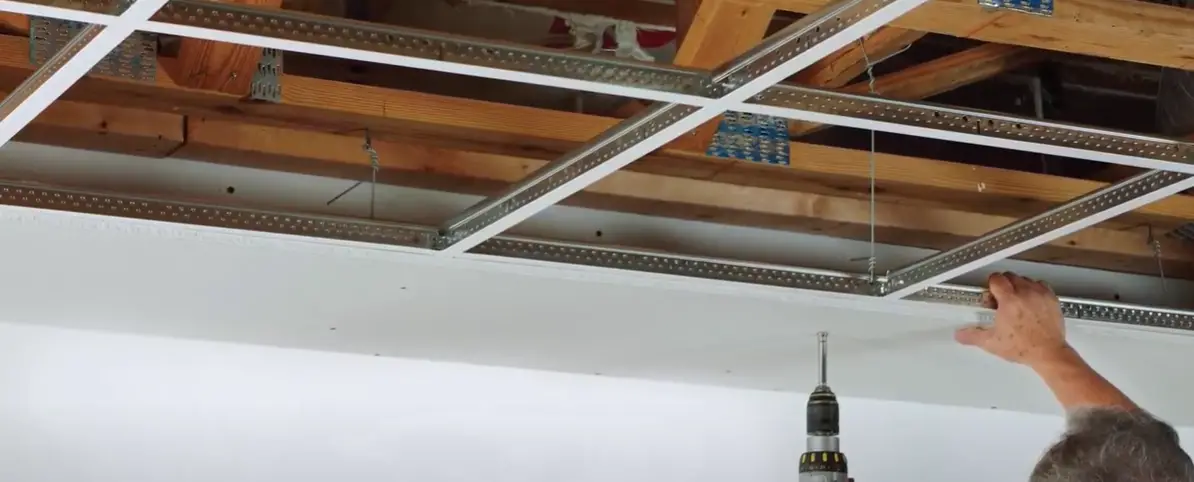
2. Veneer Plaster
Veneer plaster is a great alternative to drywall, as it can be finished with a smooth texture. It is a thinner mix of conventional plaster and joint compound, applied over gypsum board or any other type of interior wallboard. When veneer plaster is applied in multiple thin coats, the finish is durable and easy to clean. Additionally, because it’s a thin material, it works well in tight spaces like closets or hallways where regular drywall may not fit.
Veneer plaster is applied with a trowel similar to regular plaster but it only requires one coat, making the process much easier and faster than drywall installation. Application does require special skills so it’s essential to hire an experienced professional for the job. The cost of veneer plaster will vary depending on the surface area you need covered, but it is generally slightly more expensive than drywall due to its high-end finish. With proper care and maintenance, your veneer plastered ceiling should last several years without any major issues.
3. Lath & Plaster
Lath and plaster is one of the oldest methods for ceiling construction, dating back to ancient times. The laths are thin strips of wood nailed onto the framework of your ceiling and then plastered over with a combination of lime, sand, and water. This type of ceiling was most popular in traditional homes built before the 1930s. [1]
The major advantage of lath and plaster ceilings is that they provide excellent insulation against sound, heat loss, and moisture, making them especially suitable for bedrooms or other living spaces where noise might be an issue. They also offer a more attractive finish than drywall – many people prefer the classic look it provides.
4. Plywood and Sheet Wood
Plywood and sheet wood are two other traditional ceiling alternatives to drywall. Plywood is composed of thin layers of wood bonded together, which makes it exceptionally durable and stable. On the other hand, sheet wood is composed of a single thick layer of wood, making it less expensive than plywood but also less sturdy.
Plywood and sheet wood can be left raw for a rustic look or stained to create a rich, classic finish. They’re relatively easy to install using construction adhesive and nails – just make sure to use the right type and size for your project! Both materials are moisture-resistant, so they’re suitable for humid spaces like bathrooms or kitchens.
However, plywood and sheet wood have a few drawbacks. First, they’re more difficult to paint and refinish than drywall or other materials. Additionally, they are both heavier than drywall, so extra reinforcement may be necessary when installing them. Finally, if you’re looking for a more modern look and feel in your home, these materials might not be the best option since they tend to give off a classic vibe.
5. Texture Wall Panels
Texture wall panels are a great option for those who want to give their home more depth and dimension without spending too much. These panels come in a variety of textures, ranging from smooth and sleek to rough-textured patterns. Texture wall panels can create an interesting focal point on the ceiling, while still being easy to install. It’s also a great way to add color and texture to any room, making it look unique and inviting. If you’re looking for something with a little more character than drywall, texture wall panels could be just what you need!
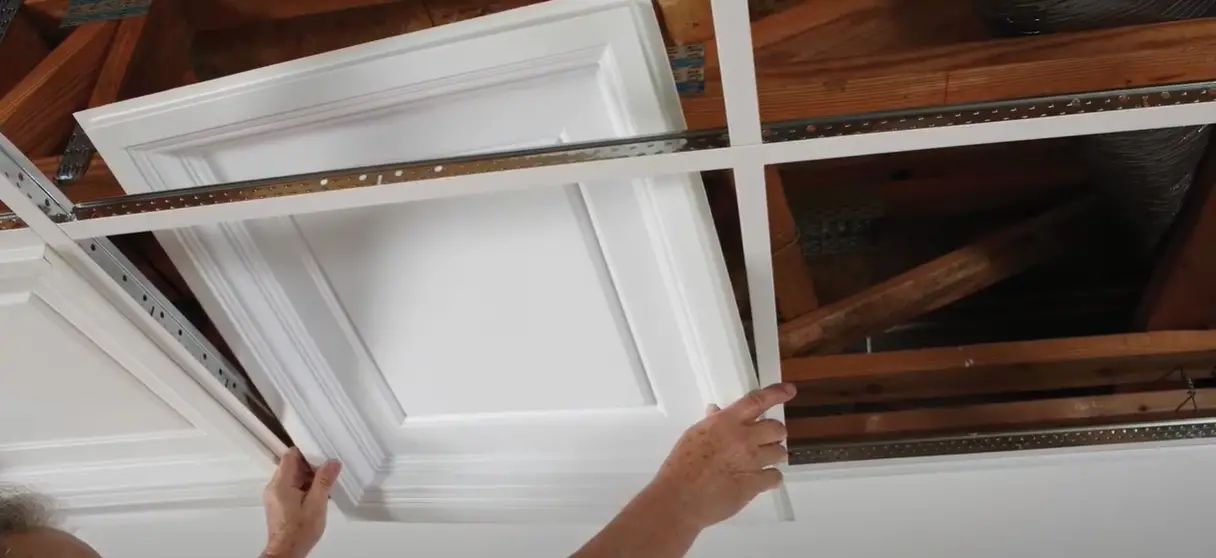
Like drop ceilings, texture wall panels can help reduce noise levels in your home by helping absorb sound waves that would otherwise bounce off of bare walls or hard floors. They are also fire-resistant and can help reduce energy bills by adding insulation. Note that installation of this type of ceiling may require the services of a professional, as it typically involves attaching each panel to the ceiling joists with special screws or clips.
6. Brick & Masonry
Brick and masonry ceilings are a great alternative to drywall. Brick has been around for centuries, and it’s still popular today for its warm, rustic charm. In addition to being durable and sturdy, brick also adds an aesthetic look that is unique to your home.
The installation process with brick ceilings can be a bit more laborious than other ceiling options, as each individual brick must be laid out before they are attached to the frame of the ceiling. Additionally, you will need to choose between veneers or real bricks in order to complete the job. Veneers are less expensive but don’t offer the same texture or sturdiness of real bricks.
The costs associated with installing a masonry or brick ceiling will vary depending on the type of materials used, as well as the size of the room being covered. Generally speaking, however, you can expect to pay more for this type of installation than you would for drywall.
7. Exposed Concrete Block
If you’re looking for a more industrial look for your ceiling, an exposed concrete block may be the ticket. This type of ceiling is becoming increasingly popular in modern and contemporary homes as a way to create an edgy look.
The great thing about this type of ceiling alternative is that it offers both aesthetic appeal and practical benefits. It is incredibly durable, fire-resistant and can help insulate your home from noise pollution. The downside is that it’s not easy to replace or repair if something goes wrong—but with proper installation, this should never be a concern.
When considering whether or not exposed concrete blocks would work in your home, make sure to consider factors like existing décor and color schemes. Since concrete blocks have a very industrial look, it might not fit in with traditional homes.
Also keep in mind that you’ll have to hire an experienced contractor for installation. If done improperly, the results could be disastrous and costly to fix. Be sure to do your research on contractors and read reviews before deciding who should install the blocks for you.
8. Cement Board
Cement board is a great alternative to drywall for finished ceilings. It’s more durable, fire-resistant and can be used in wet areas like bathrooms. Cement boards also have soundproofing qualities which makes them a better choice than drywall when sound insulation is desired. Installation of cement board involves taping the seams with fiberglass tape and then applying a thin coat of thinset mortar over the entire surface before installing tiles or other finishes. The installation process should always be done by an experienced professional to ensure that it is installed correctly and securely. Cement board is an excellent choice if your goal is to create a long lasting and durable ceiling finish.
9. Pegboard
Pegboard is a common choice for garages and workshops, but it can also work well in other areas of the home. It’s an excellent material for storage solutions and offers a unique look that no other ceiling alternative provides.
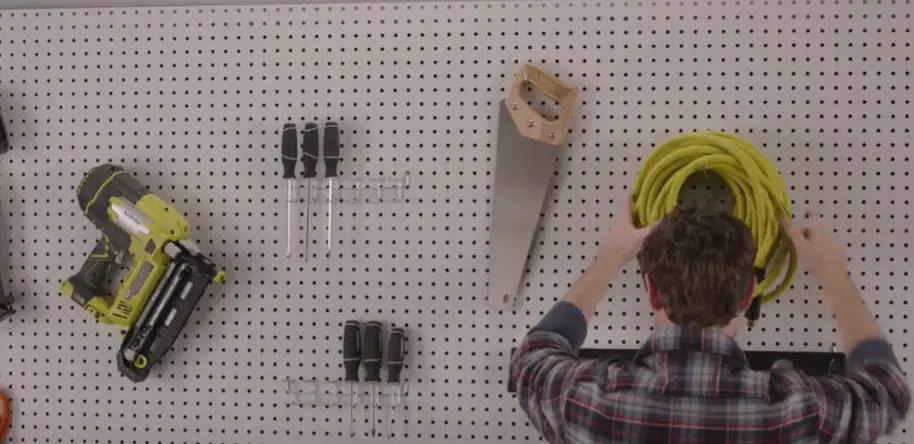
For best results, opt for either 5/8″ thick tempered hardboard or 1/4″ thick medium-density fiberboard (MDF). Both of these materials are strong enough to support heavy items and can be painted or stained any color you choose. [2]
If you’re looking for a stylish, versatile option for your ceiling that also allows for easy storage solutions, then pegboard may be the perfect choice for you!
10. Cork Board
A cork board is a great option if you’re looking for something with sound-absorption properties. This lightweight material can be installed directly onto the ceiling joists and then painted or stained to fit your home’s aesthetic perfectly. Plus, cork boards also provide some thermal insulation — making it an ideal choice for many homes.
No matter which alternative to drywall ceiling you choose, make sure that you take into account both practicality and aesthetics before deciding on a final material.
11. Wahoo Walls
Wahoo Walls are an innovative alternative to drywall for your ceiling. They are prefabricated panels made from a unique composition of expanded polystyrene foam insulation and sealed in a tough, waterproof coating. The panels come in 2-foot by 8-foot sections and can be easily cut to fit any space. Wahoo Walls offer superior soundproofing properties compared to traditional drywall as well as being extremely lightweight – making them easier and faster to install than standard drywall.
Additionally, they are fire resistant, environmentally friendly and have no off-gassing or odor associated with their installation. Wahoo Walls also come with built-in mold resistance so you don’t have to worry about mold growing on your ceiling over time. They are also available in a variety of colors and textures, so you can customize the look of your ceiling to match the rest of your home’s décor.
12. Reinforced Fiberglass & Gypsum Panels
Reinforced fiberglass & gypsum panels are a new type of ceiling material that bridge the gap between drywall and other ceiling options. It looks like regular drywall but has improved sound absorption and fire resistance properties. These panels are made from a combination of fiberglass, gypsum, and an adhesive. They’re very lightweight and can be easily installed using just a few tools. The cost is slightly more than drywall but the benefits may outweigh the added expense for many homeowners. Unlike traditional drywall, reinforced fiberglass & gypsum panels also come in various textures to help you achieve different design effects.
13. Corrugated Metal
Corrugated metal ceiling panels are an excellent choice for a commercial or industrial building. They offer several benefits in comparison to drywall, including improved soundproofing, durability and resistance to fire, as well as being lightweight and easier to install than drywall. Corrugated metal panels come in a variety of sizes and finishes, allowing you to customize the look of your ceiling to meet your needs. While this option does tend to be more expensive than other materials such as plywood or fiberboard, it is an excellent alternative if you’re looking for an industrial-style look.
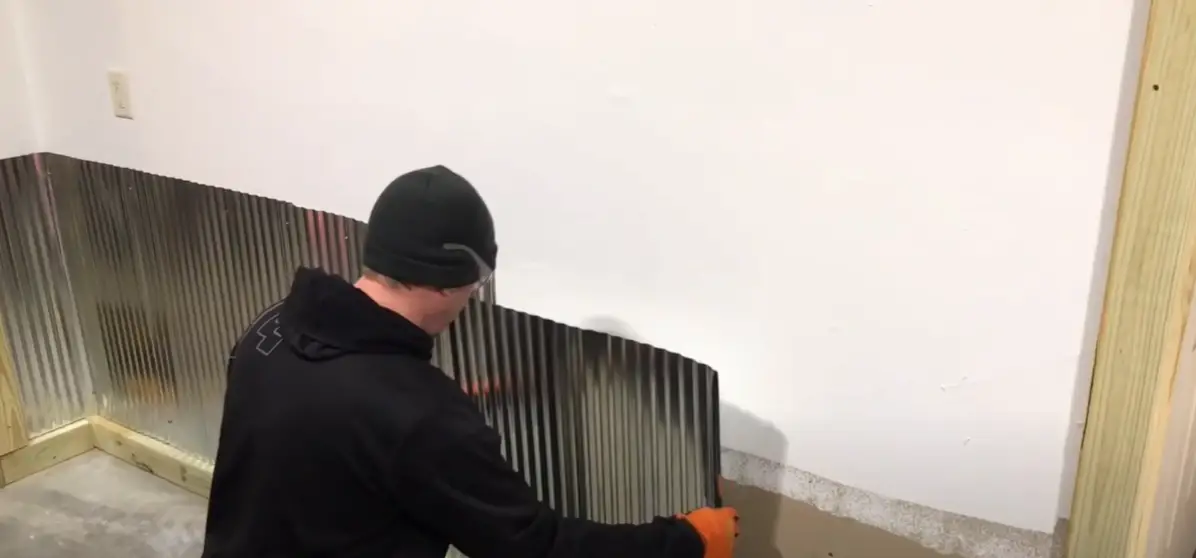
14. Vinyl Siding
Vinyl siding is a great alternative to drywall for ceilings. It is easier to install and can be painted any color you choose. Vinyl siding has the added advantage of being waterproof, making it resistant to moisture damage. The panels are available in various sizes and shapes, allowing for more creative design options than traditional drywall ceiling materials.
One of the biggest advantages of PVC vinyl siding over drywall is that it doesn’t require any additional nailing or screwing, as it already has a secure snap-lock system built into the material. This makes installation much faster and easier than with traditional drywall techniques. However, if you need to hang anything heavier than typical light fixtures or boards, then you may need to reinforce the material with additional nails or screws.
Vinyl siding also provides better thermal insulation than drywall, meaning it can help reduce your energy bills. It’s also resistant to rot and insects and can easily be cleaned using regular soap and water. Finally, since vinyl siding is manufactured in a variety of colors, you can choose the one that best complements your home interior. [3]
Comparison of Alternatives to Drywall Ceiling for Your Home
This table provides a comparison of various alternatives to drywall ceilings for your home. Drywall is a commonly used material for ceilings, but there are several alternative options available that offer different benefits and characteristics. The table presents key indicators to help you make an informed decision when choosing the right ceiling material for your home.
| Material | Cost (per square foot) | Installation Difficulty | Aesthetic Appeal | Sound Insulation | Moisture Resistance |
|---|---|---|---|---|---|
| Drywall | $1.00 | Medium | Good | Fair | Poor |
| Drop Ceiling | $2.50 | Easy | Fair | Good | Excellent |
| Tongue and Groove Wood | $3.75 | Medium | Excellent | Fair | Good |
| Metal Ceiling Tiles | $4.50 | Medium | Good | Excellent | Excellent |
| PVC Ceiling Panels | $3.00 | Easy | Good | Fair | Excellent |
Explanation:
- Material: Lists the various alternatives to drywall ceilings, including Drywall, Drop Ceiling, Tongue and Groove Wood, Metal Ceiling Tiles, and PVC Ceiling Panels.
- Cost (per square foot): Provides the approximate cost per square foot for each material, giving an idea of the price range associated with each option.
- Installation Difficulty: Rates the level of difficulty for installing each material, ranging from Easy to Medium.
- Aesthetic Appeal: Evaluates the visual appeal of each material, categorizing it as Poor, Fair, Good, or Excellent.
- Sound Insulation: Rates the sound insulation capabilities of each material, ranging from Poor to Excellent.
- Moisture Resistance: Indicates the moisture resistance of each material, categorized as Poor, Fair, Good, or Excellent.
This table aims to assist homeowners in comparing different alternatives to drywall ceilings based on cost, installation difficulty, aesthetic appeal, sound insulation, and moisture resistance. Remember that these values are approximate and subjective, and it is advisable to further research and consult professionals before making a final decision on the ceiling material for your home.
FAQ
What is the cheapest way to cover a ceiling?
The cheapest way to cover a ceiling is with traditional drywall. It is relatively inexpensive and easy to install, making it a popular choice among homeowners.
What is the easiest way to cover a ceiling?
The easiest way to cover a ceiling is with vinyl siding. It has a secure snap-lock system, making installation faster and easier than traditional drywall techniques. Plus, it comes in various colors and textures so you can easily customize the look of your ceiling.
How can I hide my bad ceilings?
One way to hide bad ceilings is with suspended tile systems. These systems consist of interlocking panels that are easy to install and can quickly cover up flaws in the ceiling. They also provide better soundproofing properties than traditional drywall, making them ideal for renters or homeowners who want to minimize noise from their neighbors.

Can you put paneling on a ceiling?
Yes, you can put paneling on a ceiling. This is a great way to add texture to a room and create an interesting design element. The panels come in various colors and sizes so you can customize the look of your ceiling to fit the style of your home. However, paneling may not provide the same soundproofing benefits as traditional drywall or reinforced fiberglass & gypsum panels. [4]
What are the alternatives to drywall for a ceiling?
There are several alternatives to drywall that you can consider for your ceiling:
- Tongue and groove paneling: Tongue and groove paneling is made of interlocking boards that create a seamless and attractive ceiling.
- Ceiling tiles: Ceiling tiles come in various materials, such as metal, PVC, and acoustic panels. They are easy to install and offer a decorative element to your ceiling.
- Gypsum board: Gypsum board, also known as plasterboard or sheetrock, is similar to drywall but offers more flexibility in terms of design and finishing options.
- Wood planks: Installing wood planks on the ceiling adds warmth and character to the room. You can choose from different types of wood, including cedar, pine, or reclaimed wood.
- Metal ceiling panels: Metal ceiling panels, such as tin or aluminum, create a unique and industrial look. They are durable, easy to clean, and available in various patterns.
- Fiberboard panels: Fiberboard panels are made from compressed wood fibers and are lightweight, affordable, and easy to install.
What are the benefits of using tongue and groove paneling for a ceiling?
Tongue and groove paneling offers several advantages for your ceiling:
- Aesthetics: Tongue and groove paneling creates a seamless look with no visible gaps, giving your ceiling a clean and polished appearance.
- Durability: The interlocking boards of tongue and groove paneling provide structural strength and can withstand the test of time.
- Easy installation: Installing tongue and groove paneling is relatively straightforward, and it can be done by a homeowner with basic DIY skills.
- Versatility: This type of paneling comes in various wood species, finishes, and widths, allowing you to choose the style that best suits your home’s aesthetic.
- No need for finishing: Unlike drywall, tongue and groove paneling does not require extensive finishing work. Once installed, it can be left natural or stained and sealed to enhance its appearance.
What are the considerations when using ceiling tiles as an alternative to drywall?
When opting for ceiling tiles, there are several factors to consider:
- Material: Determine the material that suits your needs and aesthetic preferences. Metal tiles provide a modern look, while PVC or acoustic tiles offer different levels of sound absorption.
- Installation: Evaluate the ease of installation. Some ceiling tiles require adhesive, while others can be suspended from a grid system.
- Maintenance: Consider the maintenance requirements of the ceiling tiles. Some materials are easy to clean, while others may require special care.
- Design and patterns: Explore the variety of designs and patterns available to find a style that complements your overall interior design.
- Budget: Set a budget and compare the costs of different ceiling tile options, including both the material and installation expenses.
What are the advantages of using wood planks for a ceiling instead of drywall?
Using wood planks for your ceiling offers several benefits over traditional drywall:
- Natural and warm aesthetic: Wood planks add a warm and inviting feel to any room, creating a cozy atmosphere.
- Texture and character: The natural grain and texture of wood provide a unique and visually appealing element to the ceiling.
- Durability: Wood planks are sturdy and long-lasting, especially when properly maintained.
- Easy installation: Installing wood planks is relatively simple, and many options come with tongue and groove edges for easy interlocking.
- Acoustic benefits: Wood planks can help absorb sound and reduce echoes in a room, improving the overall acoustics.
- Customization: Wood planks come in various sizes, finishes, and species, allowing you to choose the perfect look for your ceiling.
What are the alternatives to consider if you want a unique and industrial look for your ceiling?
If you desire a unique and industrial look for your ceiling, you may consider the following alternatives:
- Metal ceiling panels: Metal panels, such as tin or aluminum, create a distinctive industrial appearance. They are available in different patterns and finishes to suit your style.
- Exposed beams and ductwork: Embrace the industrial aesthetic by leaving the ceiling beams and ductwork exposed. This design choice adds an authentic and raw feel to the space.
- Concrete or cement board: Using concrete or cement board for the ceiling creates an industrial vibe while offering durability and a modern look.
- Reclaimed materials: Incorporate reclaimed wood or salvaged materials, such as metal or corrugated sheets, to achieve an industrial aesthetic with a touch of history.
- Wire mesh panels: Wire mesh panels provide an open and industrial look, allowing for increased airflow and a unique visual appeal.
What are the advantages of using gypsum board as an alternative to drywall for a ceiling?
Gypsum board, also known as plasterboard or sheetrock, offers several advantages as an alternative to traditional drywall for ceilings:
- Design versatility: Gypsum board can be easily cut and shaped to create custom designs, curves, and architectural details on your ceiling.
- Smooth and seamless finish: When installed properly, gypsum board provides a smooth and seamless surface, giving your ceiling a clean and professional look.
- Fire-resistant properties: Gypsum board is inherently fire-resistant, offering increased safety and protection in your home.
- Improved acoustics: Gypsum board with added soundproofing materials can enhance the acoustics of a room by reducing sound transmission between floors.
- Moisture resistance: Moisture-resistant gypsum board is available, making it suitable for areas with high humidity, such as bathrooms or kitchens.
- Easy installation and repair: Gypsum board is relatively easy to install, and damaged sections can be cut out and replaced without affecting the entire ceiling.
What are fiberboard panels, and how are they used as an alternative to drywall ceilings?
Fiberboard panels are a popular alternative to drywall for ceilings. Here’s what you need to know:
Fiberboard panels, also known as medium-density fiberboard (MDF), are made from compressed wood fibers and synthetic resin. They are commonly used in construction and interior design applications.
When used as an alternative to drywall for ceilings, fiberboard panels offer several advantages:
- Affordability: Fiberboard panels are generally more cost-effective than traditional drywall, making them a budget-friendly option for ceiling finishes.
- Easy installation: These panels are lightweight and can be easily cut to size, allowing for straightforward installation with basic tools.
- Design versatility: Fiberboard panels can be painted or stained in various colors and finishes to match your desired aesthetic. They also offer options for adding decorative molding or trim.
- Durability: Fiberboard panels are resistant to warping, cracking, and shrinking, ensuring a long-lasting ceiling solution.
- Sound absorption: MDF has inherent sound-absorbing properties, which can help reduce noise transmission between floors or rooms.
Are there any eco-friendly alternatives to drywall for ceilings?
Yes, if you’re looking for eco-friendly alternatives to drywall, consider the following options:
- Bamboo panels: Bamboo is a fast-growing, renewable resource that can be used for ceiling panels. It has a unique aesthetic and offers a sustainable alternative to traditional materials.
- Cork tiles: Cork is a natural and renewable material that provides insulation and acoustic properties. Cork tiles can be installed as ceiling coverings, creating a visually interesting and eco-friendly solution.
- Recycled wood planks: Using reclaimed or recycled wood planks for your ceiling not only adds character but also reduces the demand for new materials.
- Plant-based fiber panels: Certain fiberboard panels are manufactured using plant-based fibers, such as wheat straw or bagasse, instead of traditional wood fibers. These panels offer a sustainable and eco-friendly option.
- Clay plaster: Clay plaster is a natural and breathable material that can be applied to ceilings to create a textured and environmentally friendly surface. It is non-toxic and has excellent thermal properties.
What considerations should be made when choosing an alternative to drywall for a ceiling in a humid environment?
If you’re installing a ceiling alternative to drywall in a humid environment, consider the following factors:
- Moisture resistance: Opt for materials that are specifically designed to withstand high humidity, such as moisture-resistant gypsum board or specialized ceiling tiles.
- Mold and mildew resistance: Look for materials that have built-in mold and mildew resistance, as these can help prevent growth and maintain a healthy indoor environment.
- Ventilation: Ensure proper ventilation in the room to minimize moisture buildup. Good airflow can help mitigate the effects of humidity on the ceiling materials.
- Sealing and finishing: Properly seal and finish the ceiling alternative to create a barrier against moisture infiltration. Use appropriate primers, paints, or sealants to protect the material from humidity-related damage.
- Regular maintenance: Implement a maintenance routine to address any signs of moisture damage promptly. Regular inspections and timely repairs can help prolong the lifespan of the ceiling alternative in a humid environment.
Useful Video: Drywall Ceiling Alternatives | Armstrong Ceilings for the Home
Conclusion
If you are planning a home renovation and are considering your ceiling options, there are several alternatives to drywall that may suit your needs better. These materials can provide better insulation, soundproofing, or fire resistance, depending on your priorities. No matter what route you decide to go, be sure to consult with a professional contractor to get the best results for your home.
References
- https://www.cohesivehomes.com/year-lath-and-plaster-was-stopped
- https://www.cabinetcity.net/2017/05/02/plywood-particle-board-mdf-hardboard-where-do-we-go-from-here/
- https://www.slimandtrimconstruction.com/the-benefits-of-vinyl-siding/
- https://www.duramaxpvcpanels.com/resource_faq/can-you-use-wall-paneling-for-the-ceiling/





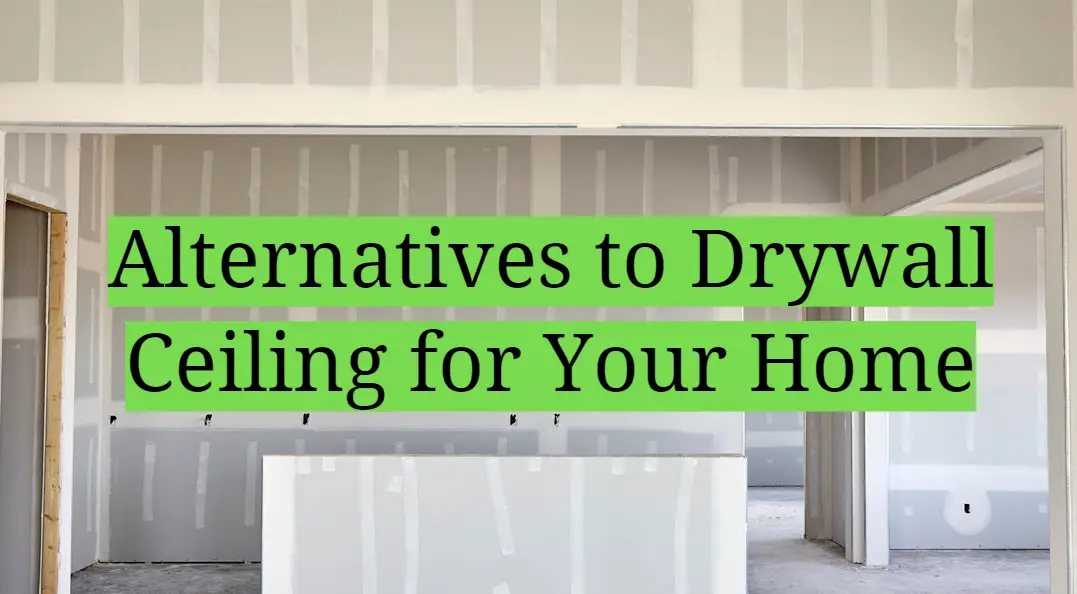




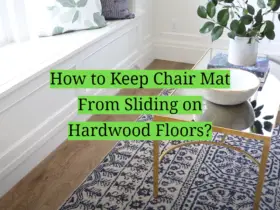



Leave a Reply